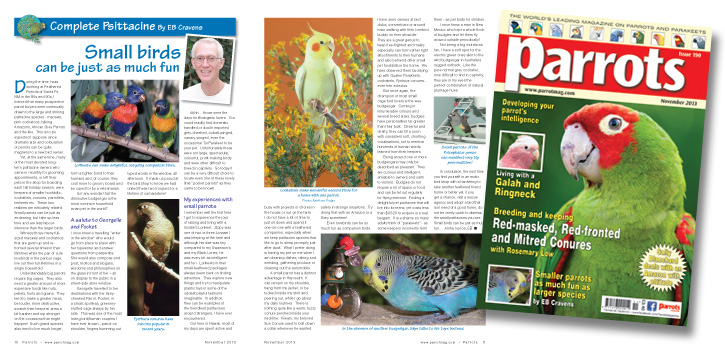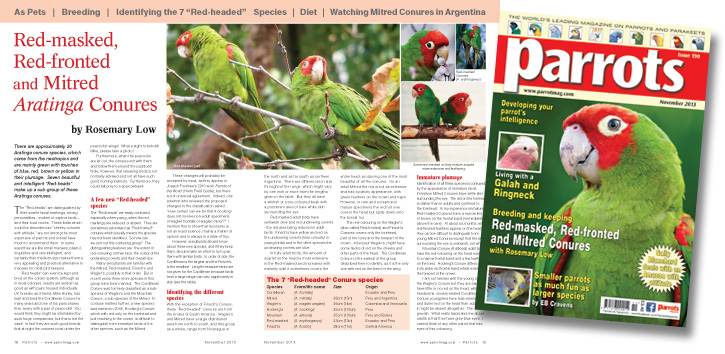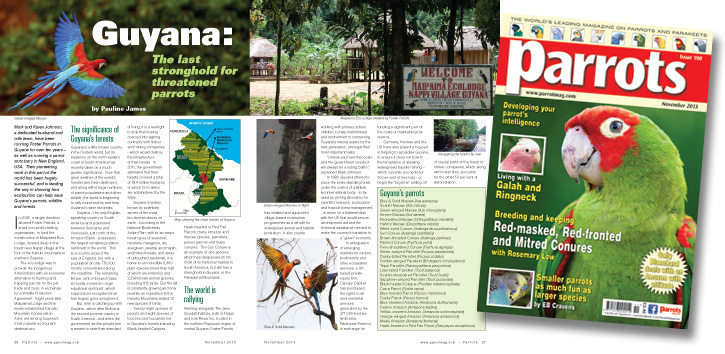
Small birds can be just as much fun
During the time I was working at Feathered Friends of Santa Fe, NM in the 80s and 90s, I noticed that many prospective parrot buyers were continually drawn to the large and striking psittacine species - macaws, pink cockatoos, talking Amazons, African Grey Parrots and the like. This is to be expected I suppose since dramatic size and colouration of parrots can be quite magnetic to a new bird owner.
Yet, at the same time, many of the most devoted long-term psittacine owners who came in monthly for grooming appointments, or left their pets in the shop for boarding each fall holiday season, were keepers of smaller hookbills - cockatiels, conures, parrotlets, lorikeets etc. These two realities are intricately related. Small parrots can be just as endearing, but take up less time and are less labour-intensive than the larger birds.
Witness those many full-sized macaws and cockatoos that are given up and re-homed several times in their lifetimes while the pair of cute lovebirds in the parlour cage, live out their full lifetimes in a single household.
Buy Now!

Red-masked, Red-fronted and Mitred Aratinga Conures
by Rosemary Low
There are approximately 20 Aratinga conure species, which come from the neotropics and are mainly green with touches of blue, red, brown or yellow in their plumage. Seven beautiful and intelligent “Red-heads” make up a sub-group of these Aratinga conures.
The “Red-heads” are distinguished by their scarlet facial markings, strong personalities - evident in captive birds – and their loud voices. These birds which could be described as “cheeky conures with attitude,” are not among the most expensive of parrots and overall have much to recommend them. In some ways they are like small macaws, playful, inquisitive and very intelligent, and certainly their medium-size makes them a very appealing and practical alternative to macaws for most bird keepers.
“Red-heads” can even be kept and bred on the colony system, although as in most colonies, results are seldom as good as with pairs housed individually. UK breeder and friend, Mike Hurley, has kept and bred the Cordilleran Conure for many years and one of his pairs shares their aviary with a pair of peacocks! You would think they might be intimidated by such huge companions, but this is not the case! In fact they are such good friends that at night the conures roost under the peacocks’ wings! What a sight to behold! Mike, please take a photo!
Buy Now!

Guyana: The last stronghold for threatened parrots
by Pauline James
Mark and Karen Johnson, a dedicated husband and wife team, have been running Foster Parrots in Guyana for over ten years – as well as running a parrot sanctuary in New England, USA. Their pioneering work in this part of the world has been hugely successful, and is leading the way in showing how ecotourism can help save Guyana’s parrots, wildlife and forests.
In 2005, a single donation allowed Foster Parrots, a small non-profit-making organisation, to fund the construction of Maipaima Eco-Lodge, located deep in the forest near Nappi village at the foot of the Kanuki mountains in southern Guyana.
The eco-lodge was to provide the indigenous Amerindians with an economic alternative to hunting and trapping parrots for the pet trade and zoos, in exchange for a Wildlife Protection Agreement. Eight years later Maipaima Lodge and the newly-established Kanuku Mountain Conservation Area, are among Guyana’s most popular ecotourism destinations.
Buy Now!



